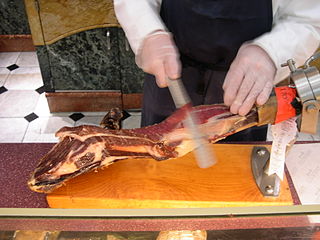Among various other things, Spain to me represents one enormous banquet table, laden with distinctive and delicious treats from every corner of the land and surrounding seas. But I daresay there’s nothing more distinctive in the country – or in Europe, for that matter – than the ubiquitous sight of cured ham hanging in bars, tabernas, and restaurants throughout this country (not even in Italy do you see this, despite the popularity of its similar ham, prosciutto, and Italians eat just half the amount of cured ham that Spaniards do each year). It’s a tradition that dates back on the Iberian peninsula thousands of years, at least to the time of ancient Greece (though there was of course a bit of an interruption while the ham-averse Muslims were in the saddle hereabouts).
 These days, this particular ham is still produced by age-old traditional methods – not cooked but rather salted and dried from seven months to three years at a high elevation, resulting in a dense, intense flavour that fairly blossoms and then melts in your mouth. It’s usually served thinly sliced directly off those hanging legs of ham, eaten by itself, with a cheese such as manchego, and/or a nice crusty bread or breadsticks. There are several types, depending on the breed of pig, the way they’ve been raised and fed, the curing methods, and the specific parts of the pig used.
These days, this particular ham is still produced by age-old traditional methods – not cooked but rather salted and dried from seven months to three years at a high elevation, resulting in a dense, intense flavour that fairly blossoms and then melts in your mouth. It’s usually served thinly sliced directly off those hanging legs of ham, eaten by itself, with a cheese such as manchego, and/or a nice crusty bread or breadsticks. There are several types, depending on the breed of pig, the way they’ve been raised and fed, the curing methods, and the specific parts of the pig used.
The most common type is jamón serrano(Serrano ham, literally “mountain ham,” referring to the high-elevation curing process), which comes from farm-raised, grain-fed white pigs and has official European “designation of origin” status similar to Champagne or cheeses like Parmigiano and Roquefort (some designation of origins can get pretty specific, as in the case of Teruel, Girona, and the Andalusian village of Trevélez).
 There are also several grades above jamón serrano, variants of what’s called jamón ibérico because it comes from the cerdo ibérico, or Black Iberian pig. These range from farm-raised/grain-fed up to the top of the line: jamón ibérico de bellota, from free-range Black Iberian pigs who roam oak forests and whose favourite food is acorns (bellotas) – and let me tell you, that sublime nutty quality definitely comes across in the flavour on the plate. Much of this production comes from areas like Salamanca, Ciudad Real, Cáceres, Badajoz, Seville,Córdoba, and Huelva (whose town of Jabugo is also perhaps the most famous ham name in all of Spain).
There are also several grades above jamón serrano, variants of what’s called jamón ibérico because it comes from the cerdo ibérico, or Black Iberian pig. These range from farm-raised/grain-fed up to the top of the line: jamón ibérico de bellota, from free-range Black Iberian pigs who roam oak forests and whose favourite food is acorns (bellotas) – and let me tell you, that sublime nutty quality definitely comes across in the flavour on the plate. Much of this production comes from areas like Salamanca, Ciudad Real, Cáceres, Badajoz, Seville,Córdoba, and Huelva (whose town of Jabugo is also perhaps the most famous ham name in all of Spain).
There are even, believe it or not, health benefits to moderate indulgence in this tasty artisanal treat, especially the ibéricos – yes, you’ll note the ham is marbled with fat, but because of the Black Iberia pigs’ acorn diet it’s mostly oleic acid, which lowers LDL cholesterol and boosts HDL cholesterol.
And while of course you can find these luscious pork products in gourmet shops and Spanish restaurants beyond the borders of Spain, what’s exported is but the tip of the proverbial iceberg. There’s nothing like enjoying this most Spanish of delicacies in typical Spanish surroundings with a glass of sherry or a caña (draught beer).
So what do you say – time to ham it up this year?
images | Jardoz, Evaglesias, Schellack

Comments
Count me in for the jamón ibérico de bellota, (free-range Black Iberian pork raised on acorns)! Next up is the flavor possibilities pairing up w/ various cañas...